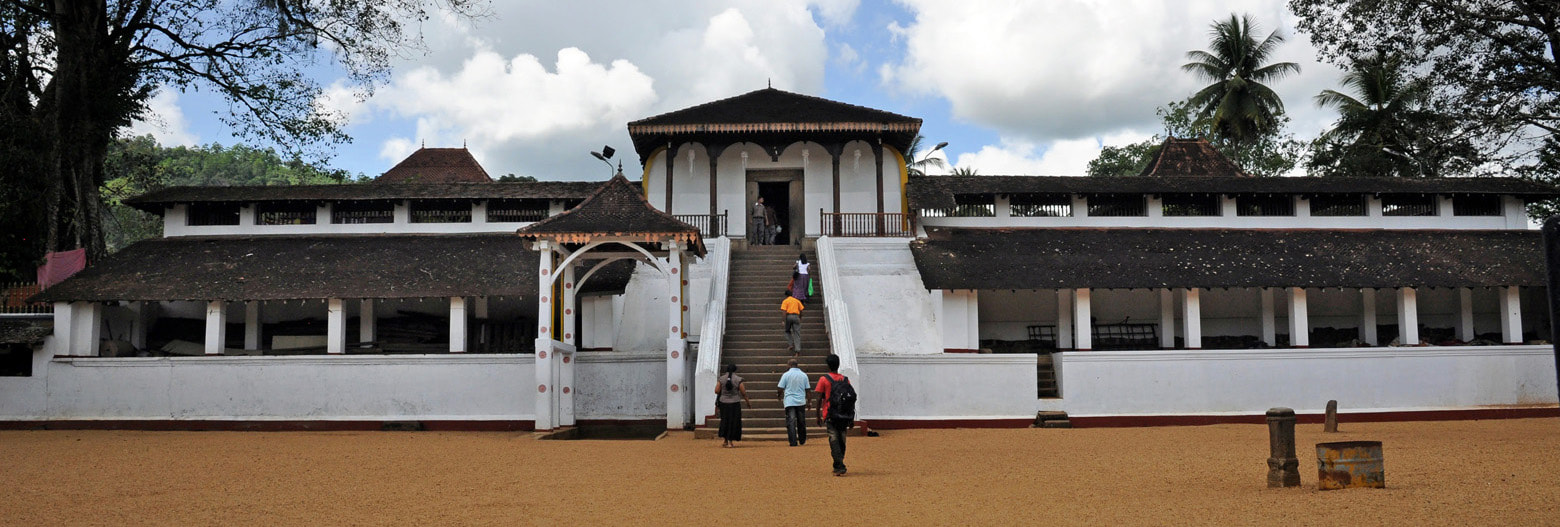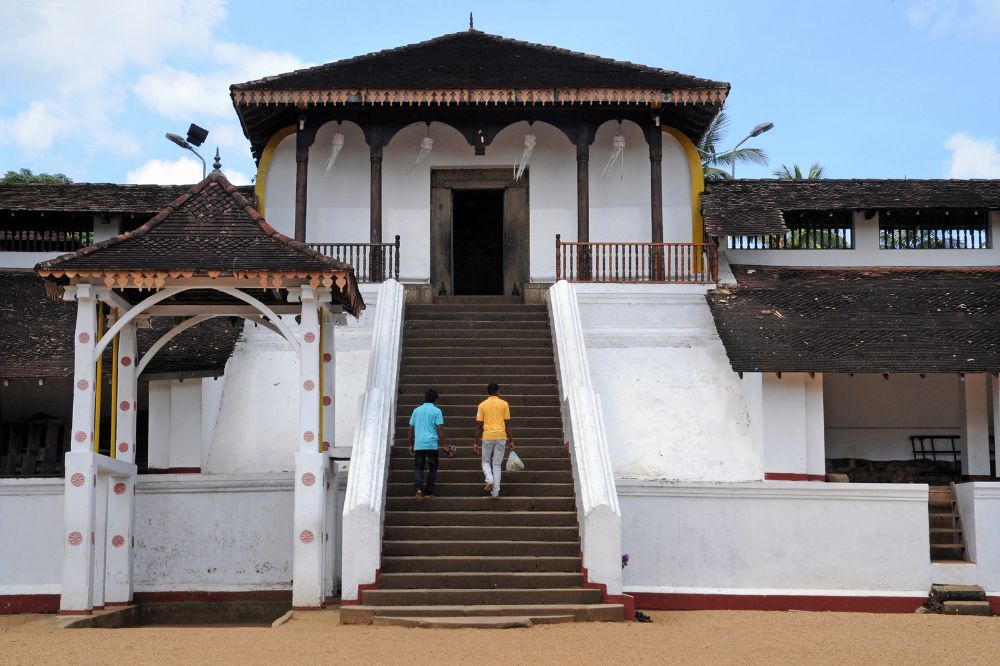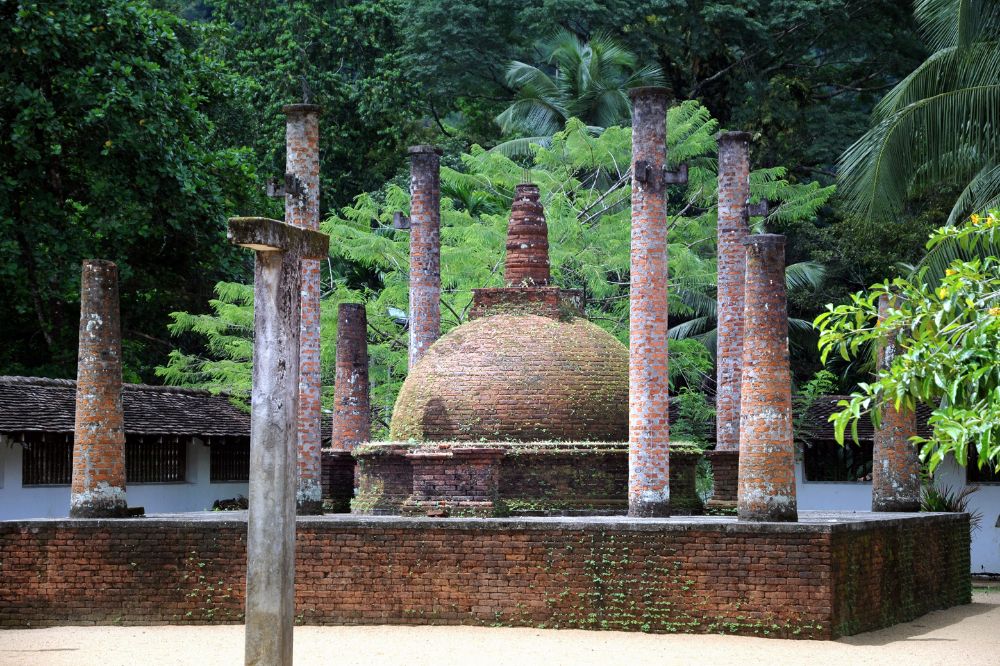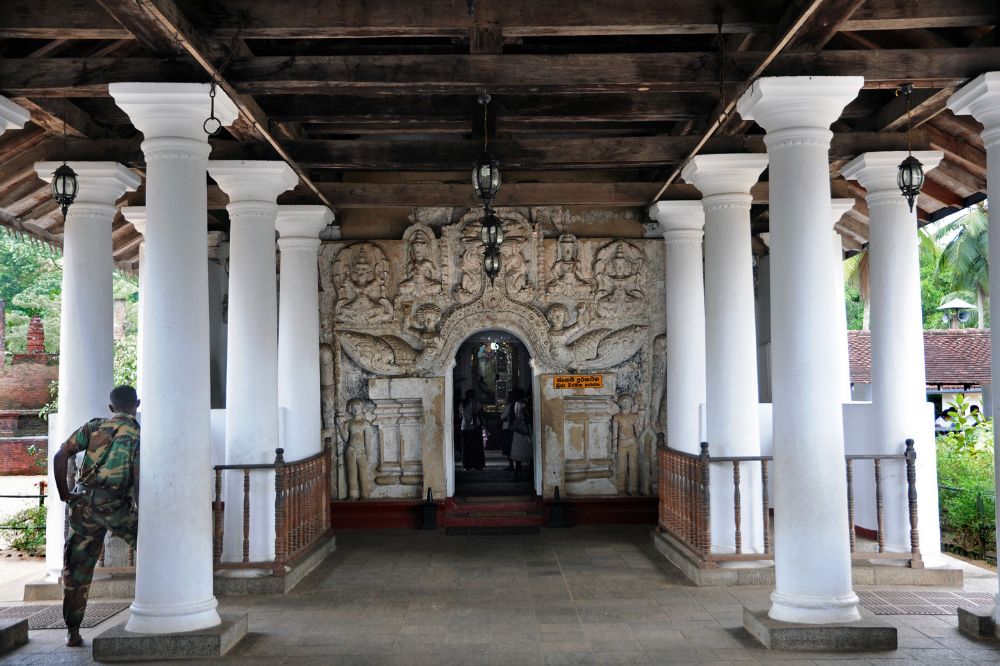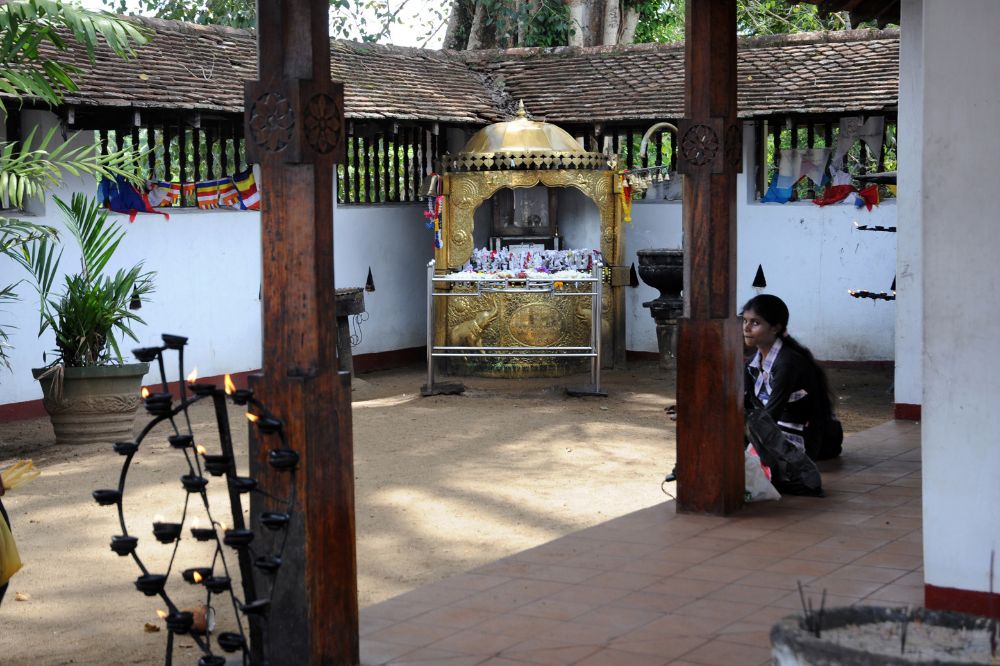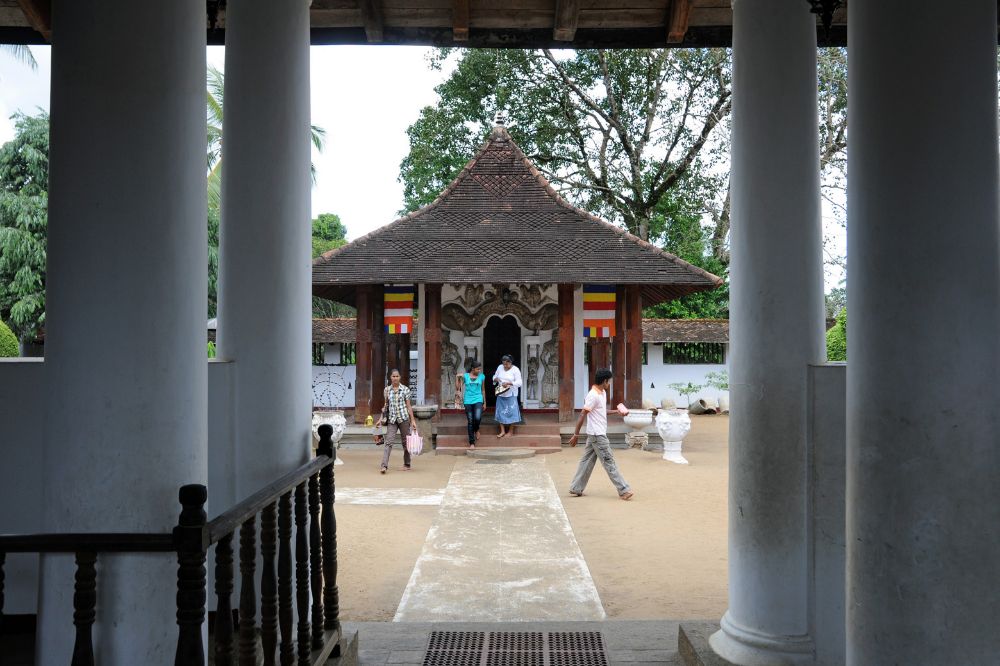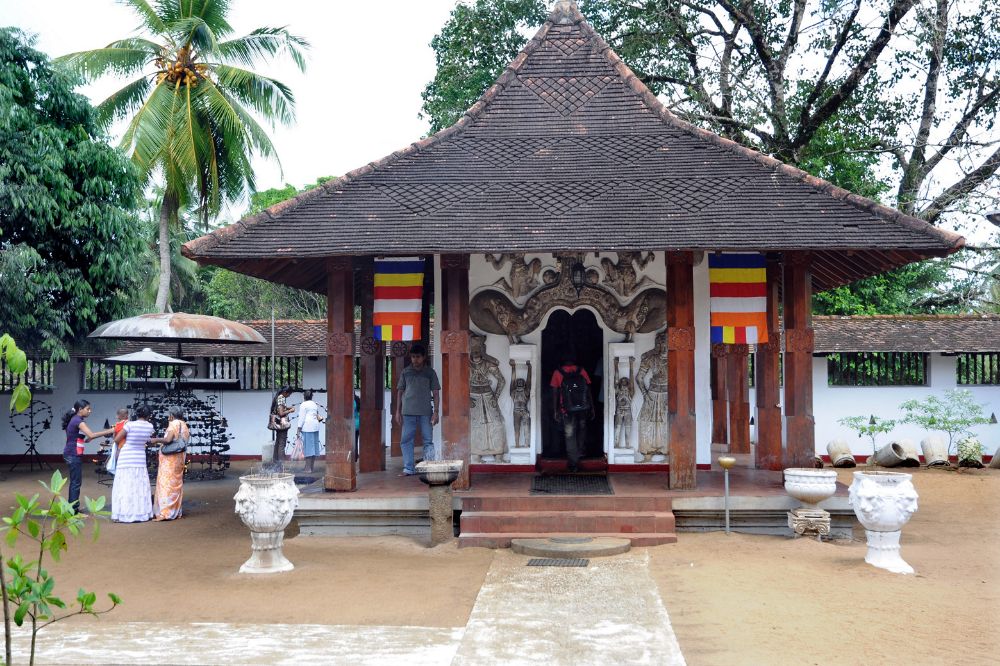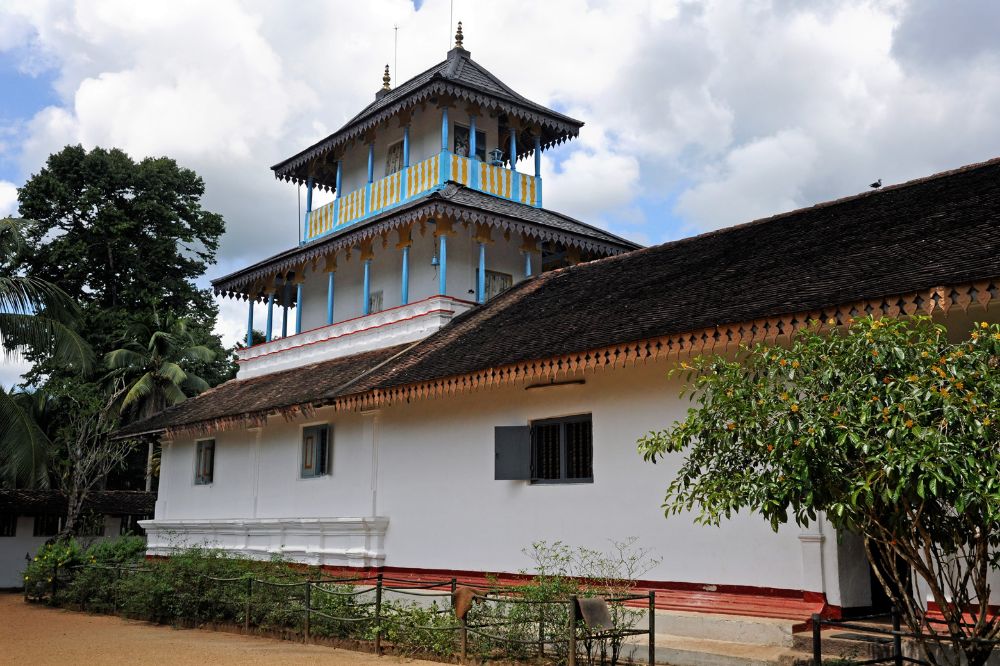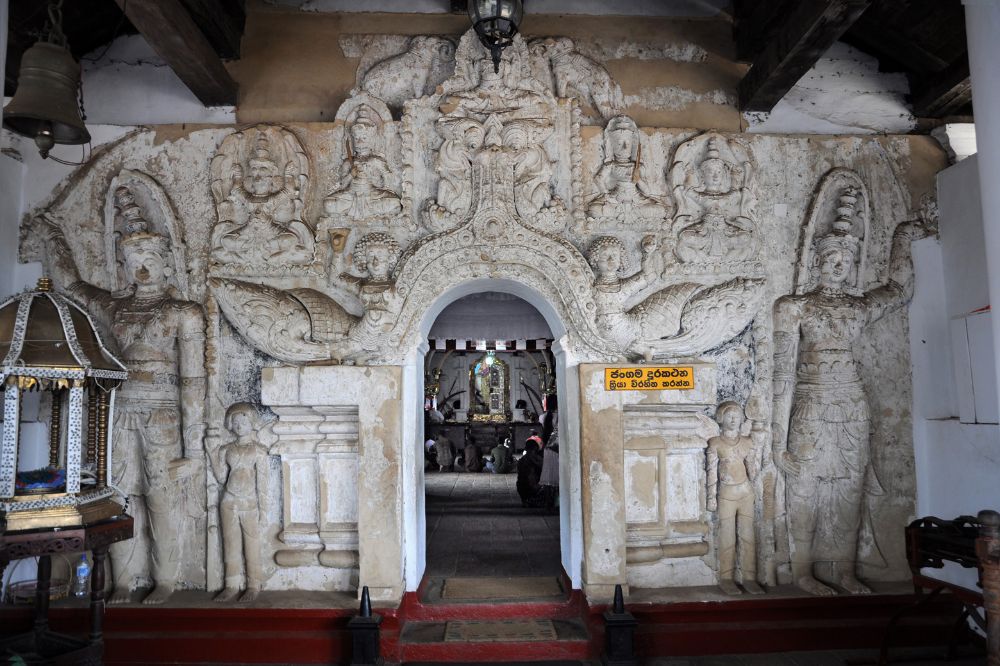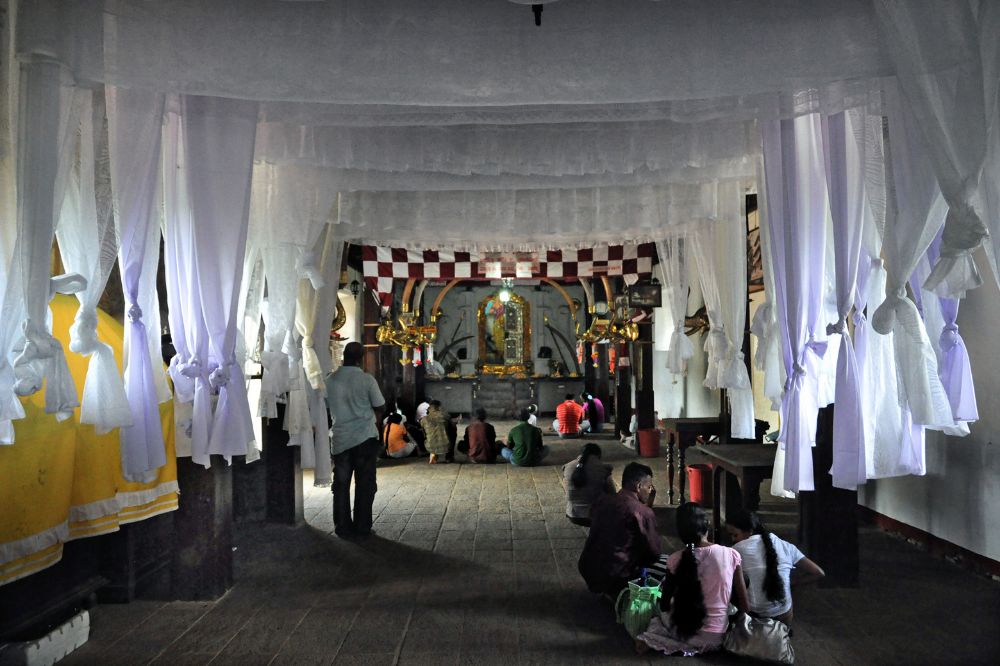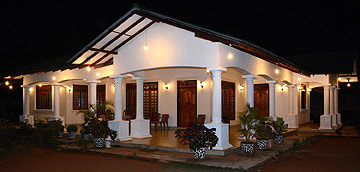Maha Saman Devale, also known as Sri Sumana Saman Devalaya, is the main shrine in the region of Ratnapura. The Sinhalese sanctuary of the regional deity protecting Ratnapura and Adam’s Peak is a typical temple in the Kandyan style. In fact, it is one of the largest Kandyan buildings, second only to the Temple of the Sacred Tooth Relic in Kandy. Perched on a mound, the Maha Saman Devale has a nice series of courtyards and whitewashed shrines with tiled roofs.
Originally built in the 13th century, the temple was destroyed by the Portuguese in the 16th century and rebuilt by the kings of Sitavaka. The current structures are from the late Kandyan period. The main sanctuary in the very centre of the complex is dedicated to Saman, a former demon converted to Buddhism and now the protector of the southwestern hillcountry and Sabaragamuwa province. Side shrines honouring the Buddha and the goddess Pattini can be seen in the adjacent courtyards. The annual temple festival is held in the month of Esala. It is one of the largest pageants of Sri Lanka, less known to tourists. Those travellers seeking an experience of a genuine Sri Lankan festival without crowds of other foreigners, should consider to visit the Ratnapura Perahera. It usually takes place in the first weeks of August.
Originally built in the 13th century, the temple was destroyed by the Portuguese in the 16th century and rebuilt by the kings of Sitavaka. The current structures are from the late Kandyan period. The main sanctuary in the very centre of the complex is dedicated to Saman, a former demon converted to Buddhism and now the protector of the southwestern hillcountry and Sabaragamuwa province. Side shrines honouring the Buddha and the goddess Pattini can be seen in the adjacent courtyards. The annual temple festival is held in the month of Esala. It is one of the largest pageants of Sri Lanka, less known to tourists. Those travellers seeking an experience of a genuine Sri Lankan festival without crowds of other foreigners, should consider to visit the Ratnapura Perahera. It usually takes place in the first weeks of August.
Location
Three kilometers (2 miles) northwest of Ratnapura, on the main road A8 towards Panadura, is one of Sri Lanka's largest temple complexes from the Kandy period. The Maha Saman Devale is, as its name suggests, dedicated to the great god Saman. Saman is the guardian of the Sabaragamuwa region and the Buddhist order and in particular the mountain Adams Peak (Siri Pada).
A pilgrimage along the classic (and more arduous) route from the lowland Ratnapura side to the summit of this holy mountain includes a visit to the shrine to Saman before the climb. This is a reason why that there are always local believers praying in the temple, whereas foreign tourists are the exception.
A pilgrimage along the classic (and more arduous) route from the lowland Ratnapura side to the summit of this holy mountain includes a visit to the shrine to Saman before the climb. This is a reason why that there are always local believers praying in the temple, whereas foreign tourists are the exception.
Temple Buildings of the Maha Saman Devale
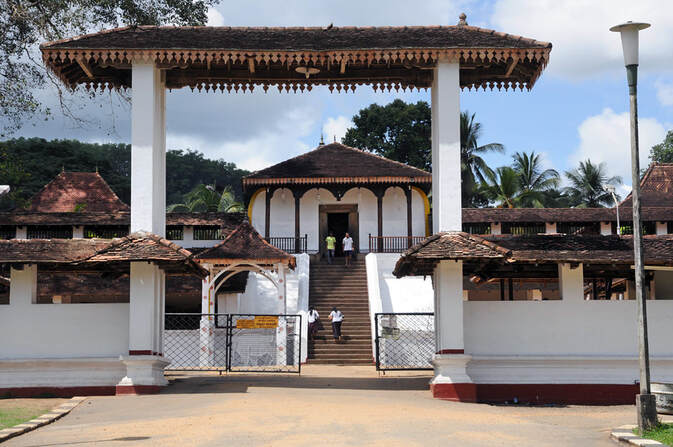
„Devale“ or „Devalaya“ is the Sinhalese name for a temple for gods that are venerated by Buddhists. For them, gods are powerful beings subordinate to the Buddha and protecting his religion. Therefore, it is not entirely correct to call the Saman temple a Hindu shrine. Saman is a local god and patron saint of Buddhism.
The temple lies at the end of a wide processional route and has an impressively wide front because it is leaning on the slope of a hill. The white wall of the main courtyard on a higher platforrm and looks like an upper floor from a distance.
The structure of the building into several courtyards with a large number of side shrines as well as the dominant white colour of the facades are typical of buildings from the Kandyan era.
In addition to the main gate on the east side, the rectangular ground-level forecourt has a second entrance from the south. The lower courtyard is where the elephants are decorated for the grand Perahera procession. This largest festival in southwest Sri Lanka takes place in the Buddhist month of Esala, in July or August, coinciding with the even more famous Kandy Perahera. As in Kandy, processions take place every night between the new moon and the full moon. Size and pomp of the pageants increase towards the end of the festival season.
The temple lies at the end of a wide processional route and has an impressively wide front because it is leaning on the slope of a hill. The white wall of the main courtyard on a higher platforrm and looks like an upper floor from a distance.
The structure of the building into several courtyards with a large number of side shrines as well as the dominant white colour of the facades are typical of buildings from the Kandyan era.
In addition to the main gate on the east side, the rectangular ground-level forecourt has a second entrance from the south. The lower courtyard is where the elephants are decorated for the grand Perahera procession. This largest festival in southwest Sri Lanka takes place in the Buddhist month of Esala, in July or August, coinciding with the even more famous Kandy Perahera. As in Kandy, processions take place every night between the new moon and the full moon. Size and pomp of the pageants increase towards the end of the festival season.
Not exactly located in an axis of symmetry, a staircase of 25 steps leads to the upper platform. The white prakaras, as the outer walls of a sanctuary in South Asia are called, are covered with tiles. In addition to the central main shrine, the central courtyard contains many smaller subsidiary shrines and rooms for the clergy as well as storage chambers for the revered objects that are carried by the elephants during the annual procession and thus brought close to the believers. The appearance of the courtyard is particularly characterized by colonnades. Not surprisingly, the temple also includes a stupa and a bo tree.
In front of the main shrine there is an open pillared hall as the most striking structural element and as a kind of distribution point in the courtyard. The lower parts of spaces in betweein columns are filled with a half-height wall. Such columned porches of Sinhalese shrines are drummers’ halls called digge.
In front of the main shrine there is an open pillared hall as the most striking structural element and as a kind of distribution point in the courtyard. The lower parts of spaces in betweein columns are filled with a half-height wall. Such columned porches of Sinhalese shrines are drummers’ halls called digge.
Openings in the half wall on the sides of the hypostyle hall lead to the side temples, one for the Buddha is on the north side. And the south side is a sanctuary for the goddess Pattini.
for more information about Pattini click here...
A subsidiary shrine for the worship of the Buddha belongs to every Devale. And the cult of Pattini as a bringer of fertility and protector against illness is very popular; Pattini shrines can be found almost everywhere in Sri Lanka. But her worship besides Saman in this sanctuary is remarkable in that she is a goddess who in some ways replaced the god Saman. Since the beginning of Sinhalese culture, there has been a group of four, sometimes five, deities who enjoy the highest reverence. Although they have a local or regional connection, like the traditional folk gods, they are revered in all parts of Sri Lanka as guardians of the island and the Buddhist religion. However, membership in this highest part of the pantheon is not canonically fixed. And the most famous example that there can be changes in the question of who is to be counted among the main gods is the introduction of the cult of Pattini under the last dynasty of Kandyan kings. They brought the Pattini cult with them from their southern Indian area of origin and promoted it so successfully in Sri Lanka that Pattini is now revered across the entire island, whereas Saman largely lost this supra-regional status. For sure, he has remained to be the most worshiped god in Sabaragamuwa Province, but is of secondary importance in Kandy and other important places of worship. The fact that such a displacement of one cult by another does not have to be interpreted as a rivalry and as a triumph of the true religion, as in the Western tradition, can be seen from the fact that the new deity did not push the older one out of their ancestral home and that her place of worship was simply added and integrated.
The three-story main shrine for Saman is also called “Palace”. As a room for the image of the god, together with the pillared vestibule (Digge), it forms a typical Indian temple ensemble of a main room for the god and a mandapa for receiving his human visitors. The passage between the two areas is marked by the obligatory door guards and a relatively layered Makara arch.
History of the Sumana Saman Temple of Ratnapura
As already mentioned, today's Saman shrine is a typical sacred building of the Kandyan period. But the location of the sanctuary looks back on a much older tradition, which of course has legendary characteristics. There has probably been a representative temple building at this place of worship for Saman from the 13th century onwards. Since the time of the Dambadeniya king Parakramabahu II, cults of Hindu god have been increasingly integrated into Sinhalese Buddhism. At that time, the sandalwood statue of the god Saman is said to have been brought here by a minister. At least that is how the historical chronicles are interpreted. Legend tells of a miraculous discovery of this statue by a Buddhist monk on a pilgrimage to Siri Pada (Adam's Peak).
The Portuguese systematically destroyed pagan sacred buildings in their territory, and the older Saman Devale also fell victim to them. They built a fort and a church on this site. As early as the late 16th century, King Rajasingha I (1581-93) of Sitavaka is said to have tried to reconstruct the temple and, after a long interruption, carried out a Perahera again. As core part of the procession the Sacred Tooth was brought to the temple, which thus had the great honor of being one of Sri Lanka's tooth temples, although Ratnapura was never the capital and the tooth relic was otherwise actually kept in the king's residence. But times changed with the arrival of the Portuguese. Safe distance from the Christian iconoclasts was a priority.
During the Dutch colonial period, the Catholic Church throughout the island came under pressure. At that time, under the Kandyan King Rajasingha II (1635-87), the Catholic church building at this point was destroyed and work began on rebuilding the sanctuary, the basic features of which are preserved, though today’a appearance is of course of even more recent origin.
The Portuguese systematically destroyed pagan sacred buildings in their territory, and the older Saman Devale also fell victim to them. They built a fort and a church on this site. As early as the late 16th century, King Rajasingha I (1581-93) of Sitavaka is said to have tried to reconstruct the temple and, after a long interruption, carried out a Perahera again. As core part of the procession the Sacred Tooth was brought to the temple, which thus had the great honor of being one of Sri Lanka's tooth temples, although Ratnapura was never the capital and the tooth relic was otherwise actually kept in the king's residence. But times changed with the arrival of the Portuguese. Safe distance from the Christian iconoclasts was a priority.
During the Dutch colonial period, the Catholic Church throughout the island came under pressure. At that time, under the Kandyan King Rajasingha II (1635-87), the Catholic church building at this point was destroyed and work began on rebuilding the sanctuary, the basic features of which are preserved, though today’a appearance is of course of even more recent origin.
God Sumana Saman - Guardian Deity of Siri Pada (Sumanakuta)
Saman actually means the rising sun. Saman is known by various similar-sounding names, for example Sumana or Samanta. He is sometimes identified with the god of the island's west, Vibhishana, who by the way is a comparable contender on the list of four or five supreme gods of Sri Lanka. Saman was viewed as an ancestral king of a local pre-Sinhalese ruling clan. But first and foremost he is a mountain god. Legends surrounding Saman deal with the Buddha’s visit to the mountain Adam's Peak, which in Sinhalese bears both the name of the god, Sumanakuta, and that of the Buddha's footprint, Siripada. The Buddha is said to have visited the mountain at Saman's invitation.
for information about the Mahavamsa Chronicle's report of God Saman click here...
But the first chapter of the Mahavansa surprisingly does not mention Saman in connection with the Buddha's third visit, during which he first set foot on the mountain, but with the Buddha's two earlier visits to other places:
Listening to the Buddha's first sermon on the island of Sri Lanka, which took place in Mahiyangana, Saman became one of the first island residents to become a Buddhist. He internalized the basic elements of the Dharma and has thus taken the first step on the path to enlightenment, which he will never leave in the course of his rebirths. In Buddhist terminology this means, God Saman is a Sotapatti, not only a lay follower who took refuge in Buddha, Dharma and Sangha,
Saman asked for hair from the Buddha as a reminder of the sermon that had inspired and conveted him. The first stupa in Sri Lanka was built for this hair at the place of the sermon in Mahiyangana. The stupa there is also home to one of the most important Saman temples outside of Saman's home province of Sabaragamuwa.
Saman also plays a prominent role in the Buddha's second visit; he lifts a tree as an umbrella over the Buddha's place from where he held another sermon.
Futhermore, Saman’s special connection to Buddhism is even explained in the Mahavansa by a report about one of his previous lives: at that time he had already met previous Buddhist enlightened people at the very same place on the Jaffna Peninsula.
Listening to the Buddha's first sermon on the island of Sri Lanka, which took place in Mahiyangana, Saman became one of the first island residents to become a Buddhist. He internalized the basic elements of the Dharma and has thus taken the first step on the path to enlightenment, which he will never leave in the course of his rebirths. In Buddhist terminology this means, God Saman is a Sotapatti, not only a lay follower who took refuge in Buddha, Dharma and Sangha,
Saman asked for hair from the Buddha as a reminder of the sermon that had inspired and conveted him. The first stupa in Sri Lanka was built for this hair at the place of the sermon in Mahiyangana. The stupa there is also home to one of the most important Saman temples outside of Saman's home province of Sabaragamuwa.
Saman also plays a prominent role in the Buddha's second visit; he lifts a tree as an umbrella over the Buddha's place from where he held another sermon.
Futhermore, Saman’s special connection to Buddhism is even explained in the Mahavansa by a report about one of his previous lives: at that time he had already met previous Buddhist enlightened people at the very same place on the Jaffna Peninsula.
